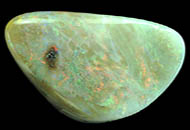|
|
| Formula: | SiO2•nH2O |  Click to see a larger image |
||
| Crystal: | Amorphous | |||
| Hardness: | 5.5-6.5 | |||
| Spec. Gr.: | 2.0-2.2 | |||
| Streak: | White | |||
| Cleavage: | N/A | |||
| Location: | Coober Pedy, Australia |
|
Opal was first discovered and used in jewelry as far in history as 500 BC. Fine opals display spectral colors with extreme brightness. The electron microscope reveals the internal structure of precious opals contains a regular lattice similar to crystalline substances. The play of colors is due to the reflection of light by finely dispersed inter-particles filled with water and spaced between spheres of silica stacked in an orderly three-dimensional pattern. Opal contains variable amounts of water and impurity ions. It opalizes various organic fossils such as shells, and petrified wood. Opal, in itself, does not crystallize. Coober Pedy is a mining district about 750k northwest of Adelaide, Australia. Discovered in 1914, it is still one of the premier opal deposits in the world. Other localities are Dubnik, Slovakia; Zimipan, Mexico; and Virgin Valley, Nevada. "Today we can see the power of superstitious belief in the case of the opal, which some timid people still fear to wear, although until three or four centuries ago this stone was thought to combine all the virtues of the various colored gems, the hues of which are united in its sparkling light." |
|
Bibliography: Kunz, George Frederick, The Curious Lore of Precious Stones, Dover Publications, New York, 1971. Bancroft, Peter, Gem and Crystal Treasures, 1984, pp. 237-240. |
|
University of California, Santa Barbara—Department of Earth Science Copyright © 2005 Regents of the University of California Send your comments to the Web Page Editor |